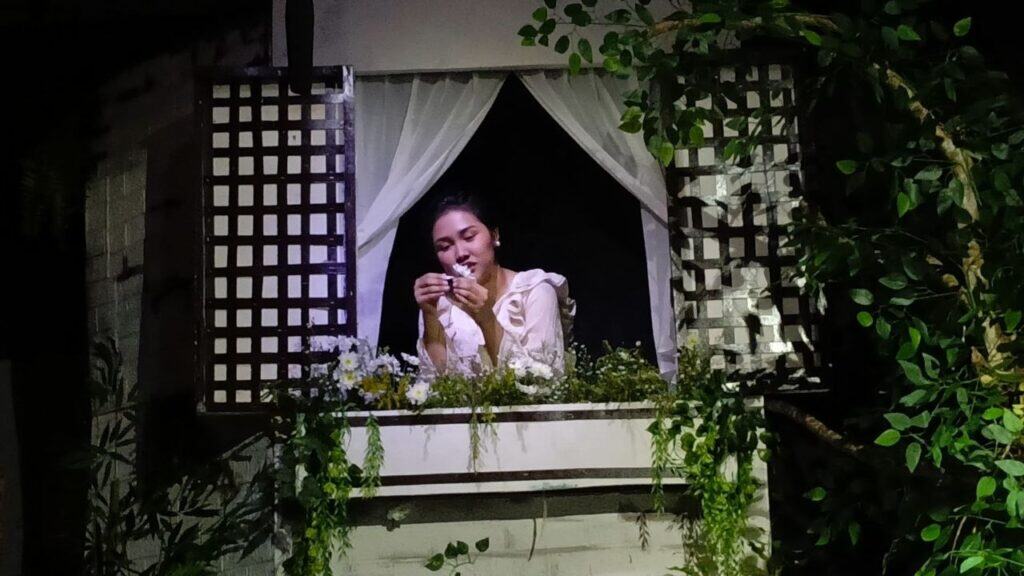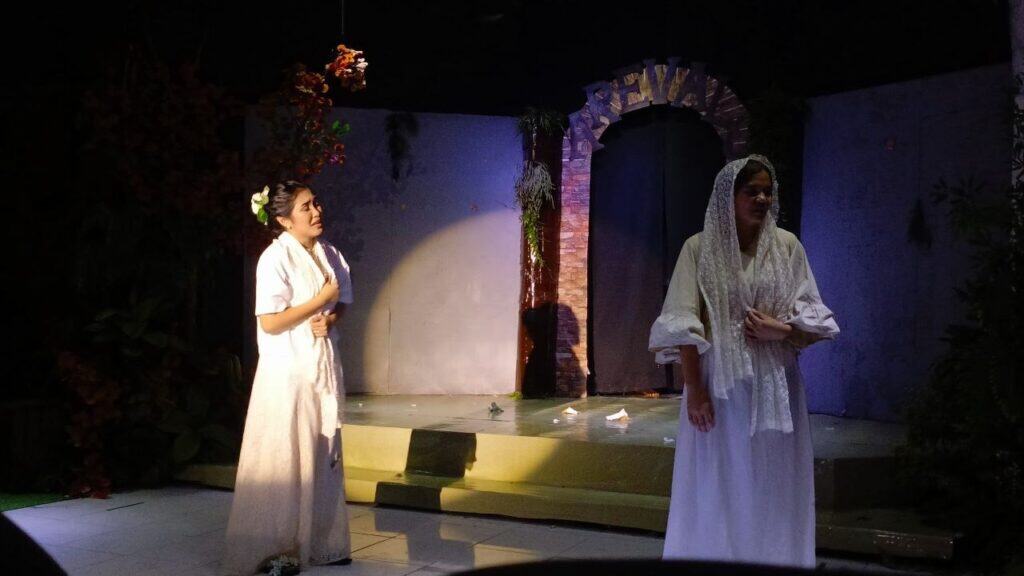Every March 27, the world comes together to celebrate World Theater Day—a tribute to the power of the performing arts to inspire, challenge, and connect people. Theater isn’t just about entertainment; it reflects our culture, history, and the issues that shape our society.
At Bicol University College of Arts and Letters (BUCAL), students embraced this spirit by bringing Caprichosa: Isang Musikal to life on March 21-22 at the CAL Amphitheatre. This Filipino adaptation of William Shakespeare’s Romeo and Juliet intertwines love and political rivalry, showcasing the complexities of power, justice, and unity. From its lead actors to the playwright and production team, the journey of mounting this play has been a transformative experience.

A Unique Filipino Take on a Classic Tragedy
Caprichosa: Isang Musikal is a reimagining of the world-renowned tragedy Romeo and Juliet, setting it against the rich cultural backdrop of the Philippines. This adaptation not only captures the timeless theme of forbidden love but also integrates Filipino traditions, music, and societal issues, making it more relatable to a local audience.
Instead of the feuding Montagues and Capulets, the story features rival political families, Villanueva and Flores, in the fictional Filipino town of Arevalo, mirroring contemporary social conflicts. The play weaves in elements of kundiman (traditional Filipino love songs), indigenous dances, and the poetic beauty of Filipino, providing a fresh and deeply immersive experience.
Being Chosen as Lead Actors: A Mix of Pressure and Pride
For Christy Gail Molleda, playing the lead role of Julya Flores was both an honor and a challenge.
“Of course, I feel pressured, but at the same time, I’m proud of myself. I never imagined experiencing something like this,” she told BicoldotPH.
Having once auditioned for the role of Juliet in high school without success, she felt a deep sense of gratitude when she was invited to play the lead this time around.
“I believe that God has perfect timing. I’m grateful for the trust given to me, and I hope we can pass on what we learned through this process to the younger BPEA students.”
Jairus Leoncito, on the other hand, who portrayed the role of Roman Villanueva, had never envisioned himself on stage.
“Honestly, this is not my forte. I’ve always preferred working behind the scenes, making props and sets,” he admitted.
His first acting role was playing a tragic character, a gay man who was assaulted, and from there, he had to make a significant adjustment for his lead role in Caprichosa.
“This is my first time experiencing a role of this magnitude, where my grades are at stake. But I also wanted to do this at least once before I graduate,” he said.
Most Impactful Scenes
For Leoncito, one of the most striking moments in the play was when many characters perished. “It’s painful to think that people had to die before peace and unity could be achieved in a place or community. Why does it have to happen this way? Why can’t peace exist without killings?” he reflected.
Molledo, on the other hand, found deep meaning in the scene where the character Tabio dies.
“There’s a song in that scene questioning why political crimes often go unpunished. It made me realize—why is it that when politics is involved, justice is often denied to victims?” she said.
She considers this moment one of the most powerful in Caprichosa because, despite being a single scene, it encapsulates a crucial message of the play.

The Significance of Caprichosa in Global Theater
As World Theater Day highlights the importance of diversity and cultural representation in the performing arts, Caprichosa: Isang Musikal stands as a testament to how classic narratives can be reinvented to resonate with different societies.
By adapting Romeo and Juliet into a Filipino context, the play bridges the gap between Western and Eastern theatrical traditions, demonstrating that universal themes of love, family, and conflict transcend geographical boundaries.
Furthermore, the play serves as a reminder of the theater’s role in social commentary. The themes explored in Caprichosa—such as family honor, societal expectations, and the power struggles in politics—remain relevant in modern times. The production not only entertains but also encourages reflection on issues that continue to shape Filipino society.
Musical vs. Traditional Plays: A Different Kind of Challenge
Performing in a musical is vastly different from a traditional play, as Leoncito explained: “In a usual play, you rehearse your lines and deliver them with emotion. But in a musical, you need to maintain those emotions even while singing, which is incredibly difficult.”
He highlighted how challenging it is to balance hitting the right notes while staying in character. However, he believes musicals offer a deeper emotional experience compared to straight plays.
“Regular plays feel like dramas or TV series, but with musicals, I truly feel like I’m in a theater production,” he said.
For a first-time musical performer, Molledo’s experience was more demanding than she initially expected.
“At first, I thought I just had to memorize the melody and lyrics. But I soon realized that I needed to convey emotion while singing so the audience could feel the message, even if they didn’t fully understand the lyrics.”
She emphasized that while some people assume musicals focus more on melody than meaning, the actors’ emotional delivery is what truly brings the songs to life. Compared to traditional theater, musicals require an unpredictable yet compelling performance.
Challenges in Adapting the Play
As one of the playwrights and dramaturgs of Caprichosa, Jaune Jacobs discussed the many challenges they faced, particularly financial constraints and limited manpower.
“We wouldn’t have been able to mount this play without financial support. Since our class was split into two groups, we were also short on manpower. But thanks to everyone’s dedication, we pulled it off within three weeks of preparation,” Jacobs said.
Unexpected obstacles like class suspensions, extreme weather conditions, and sudden holidays also posed difficulties. Scheduling rehearsals was another challenge, as the cast members were all students balancing multiple subjects. Despite these struggles, the team remained committed to bringing the story to life.
Jacobs also emphasized the play’s political relevance, drawing parallels between historical and present-day political rivalries.
“The play portrays political dynasties, patronage, and manipulation—how politicians mold the public’s perception and how these conflicts affect not just love stories but society as a whole,” Jacobs said.
While Caprichosa is ultimately a love story, it subtly highlights deeper political themes, reflecting the realities of the past and the present.
A Celebration of World Theater Day Through Caprichosa
World Theater Day calls upon artists and audiences worldwide to appreciate the enduring power of stage performance. Caprichosa: Isang Musikal embodies the essence of this celebration by showcasing how theater can evolve while staying true to its roots. Through its adaptation of Shakespeare’s iconic love story, the play underscores the importance of cultural storytelling, reminding us that even the most familiar tales can find new life when told through the lens of a different people and tradition.
As Filipino theater continues to flourish, productions like Caprichosa inspire new generations of playwrights, actors, and audiences to embrace and reinterpret classical works. This World Theater Day, we celebrate not just the art of theater but also its ability to unite, educate, and spark meaningful conversations across the world.IFroilance Alcazar, Kyla Literal



